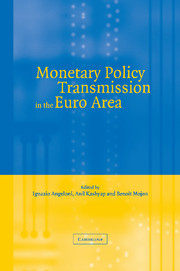 Monetary Policy Transmission in the Euro Area
Monetary Policy Transmission in the Euro Area Book contents
- Frontmatter
- Contents
- List of contributors
- Foreword by O. Issing
- Acknowledgements
- List of abbreviations
- Introduction
- Part 1 Macroeconometric evidence on the transmission mechanism in the euro area
- Part 2 Firms' investment and monetary policy: evidence from microeconomic data
- 7 Firm investment and monetary policy transmission in the euro area
- 8 Business investment and monetary transmission in Belgium
- 9 Investment and monetary transmission in Germany: a microeconometric investigation
- 10 Monetary policy and corporate investment in France
- 11 Monetary policy and firms' investment in Italy
- 12 Monetary transmission: empirical evidence from Luxembourg firm-level data
- 13 The role of trade credit and bank lending relationships in the transmission mechanism in Austria
- Part 3 The role of banks in the transmission: evidence from microeconomic data
- Part 4 Monetary policy in the euro area: summary and discussion of the main findings
- Appendix
- References
- List of figures
- List of tables
- Subject index
- Author index
7 - Firm investment and monetary policy transmission in the euro area
Published online by Cambridge University Press: 22 September 2009
- Frontmatter
- Contents
- List of contributors
- Foreword by O. Issing
- Acknowledgements
- List of abbreviations
- Introduction
- Part 1 Macroeconometric evidence on the transmission mechanism in the euro area
- Part 2 Firms' investment and monetary policy: evidence from microeconomic data
- 7 Firm investment and monetary policy transmission in the euro area
- 8 Business investment and monetary transmission in Belgium
- 9 Investment and monetary transmission in Germany: a microeconometric investigation
- 10 Monetary policy and corporate investment in France
- 11 Monetary policy and firms' investment in Italy
- 12 Monetary transmission: empirical evidence from Luxembourg firm-level data
- 13 The role of trade credit and bank lending relationships in the transmission mechanism in Austria
- Part 3 The role of banks in the transmission: evidence from microeconomic data
- Part 4 Monetary policy in the euro area: summary and discussion of the main findings
- Appendix
- References
- List of figures
- List of tables
- Subject index
- Author index
Summary
Introduction
Monetary policy is generally thought to be able to affect business investment through multiple channels. First, a traditional ‘interest rate channel’ is identified, whereby changes in market interest rates imply changes in the cost of capital, which in turn affect investment. However, the difficulties of using aggregate data to find clear evidence of this channel are well known. Second, changes in market interest rates affect the net cash flow (i.e. cash flow after interest payments) available to a firm. Given imperfect capital markets, the availability of net cash flow will have an effect on investment. This is generally referred to as the ‘broad credit channel’.
This chapter provides an investigation of those two channels based on results from a unique comparative study of the four largest euro area countries. Using rich firm databases for each country, standardised regressions were run to make comparison across countries feasible. Although, for confidentiality reasons, individual data could not be pooled – making formal statistical testing impossible – the standardisation of the analysis should still allow asymmetries in the working of these channels to be detected. In particular, reliance on firm data should make it possible to identify whether there are differences in the behaviour of firms with otherwise similar characteristics. This has a distinct advantage over the inference based on aggregate data in which ‘true’ differences in behaviour are potentially confounded by differences due to composition of the firms in the aggregate.
- Type
- Chapter
- Information
- Monetary Policy Transmission in the Euro AreaA Study by the Eurosystem Monetary Transmission Network, pp. 133 - 161Publisher: Cambridge University PressPrint publication year: 2003
- 10
- Cited by
